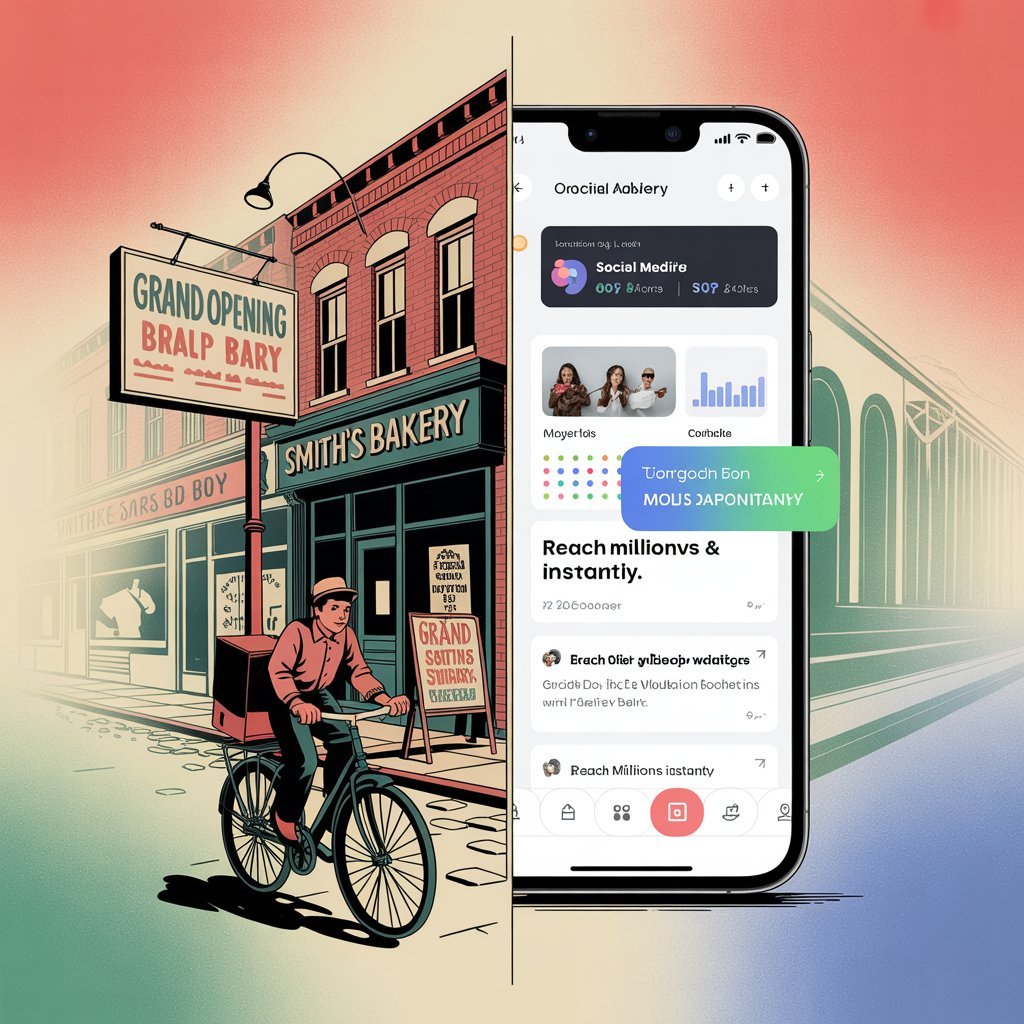Marketing can feel overwhelming, especially if you’re a small business owner juggling multiple roles. Whether you’re running a cozy bakery, launching a handmade jewelry line, or offering local landscaping services, one question inevitably comes up: How do I get the word out about my business? The answer lies in marketing—but which kind?
In this article, we’ll explore the two main types of marketing: traditional and digital. We’ll explain what they are, compare their strengths and weaknesses, and help you decide which approach (or combination) might be right for your business.
What Is Traditional Marketing?
Traditional marketing refers to the time-tested methods that have been around for decades. You’ve probably seen them in action already—even if you didn’t realize it.
Common types of traditional marketing:
- Print ads in newspapers, magazines, or flyers
- Billboards and signage on roads or in storefronts
- Radio and TV commercials
- Direct mail like postcards and catalogs
- Event marketing such as sponsoring a local fair
Traditional marketing focuses on reaching customers in the physical world, and it’s often used to target local or regional audiences.
What Is Digital Marketing?
Digital marketing uses the internet and electronic devices to promote products and services. It encompasses a broad spectrum, ranging from social media to search engines.
Common types of digital marketing:
- Social media marketing (Facebook, Instagram, TikTok, LinkedIn)
- Email marketing
- Search engine optimization (SEO) to improve visibility on Google
- Online ads, including Google Ads or Facebook Ads
- Content marketing, such as blogs, videos, or downloadable guides
Digital marketing enables businesses to reach potential customers online, where most of us spend a significant amount of our time.
Comparing Traditional and Digital Marketing
Here’s a breakdown of how the two stack up in key areas:
| Feature | Traditional Marketing | Digital Marketing |
| Cost | Generally higher upfront costs (e.g. print, TV) | More budget-friendly; can start small |
| Reach | Good for local audiences | Excellent for global or niche audiences |
| Tracking Results | Hard to measure precisely | Easy to track metrics like clicks, views, sales |
| Flexibility | Less adaptable after launch | Can be updated quickly in real time |
| Audience Targeting | Broad targeting (location-based, mass media) | Precise targeting by age, interest, behavior |
| Lifespan | Long-lasting (e.g. magazine ad, billboard) | Can have shorter but repeatable lifespan |
Which Type of Marketing Is Right for You?
Choosing between traditional and digital marketing depends on your goals, your budget, and your target audience. Let’s break that down with some practical scenarios.
When Traditional Marketing Makes Sense:
- You run a local business like a diner, salon, or auto shop where foot traffic matters.
- Your target audience includes older customers who may not be online much.
- You want to build trust in your community through presence at local events or ads in local media.
- You’re promoting a physical event—like a festival, grand opening, or local charity drive.
Traditional marketing is tangible. A flyer pinned to a community board or a well-designed shop sign can create a memorable brand impression.
When Digital Marketing Works Best:
- You’re just starting out and have a tight budget.
- Your customers are online frequently, especially younger generations.
- You want to grow your business beyond your local area.
- You sell products or services online.
- You want to track data and performance to adjust your strategy.
Digital marketing gives you flexibility, speed, and data. You can reach people on social media, build an email list, or optimize your website to attract search traffic.
Hybrid Marketing: The Best of Both Worlds
For many small businesses, a combination of both types works best.
Examples of blended strategies:
- A boutique gym sends postcards to local homes and runs Instagram ads to reach fitness enthusiasts nearby.
- A local café displays a chalkboard sign with specials, while also sharing behind-the-scenes videos on TikTok.
- A handmade soap brand sets up a booth at a craft fair, gathers email signups, and sends a weekly newsletter.
By combining traditional and digital approaches, you can reach your audience in multiple places, reinforce your message, and build trust over time.
Getting Started with a Simple Plan
Here’s a simple three-step framework to help you decide where to focus your marketing efforts.
Know Your Audience
- Who are they? (Age, interests, habits)
- Where do they spend their time? (Online or offline?)
- What problems can you solve for them?
Set Clear Goals
- Do you want to increase foot traffic, website visitors, or brand awareness?
- Are you launching a new product or just trying to boost general visibility?
Start Small and Test
- Choose one or two tactics to begin with.
- For traditional: Try a well-placed flyer or a local newspaper ad.
- For digital: Set up a business profile on social media and share helpful tips or updates.
- Track what works. Digital platforms often have built-in analytics, and with traditional marketing, you can ask, “How did you hear about us?”
Marketing doesn’t have to be intimidating. Whether you go traditional, digital, or mix the two, the most important thing is to understand your audience and meet them where they are.
Start small. Learn what works. Then build on your success.
If you’re feeling unsure where to begin, you don’t need to go it alone. Even modest efforts, like posting consistently on social media or sponsoring a local charity event, can go a long way in growing your brand. Need help with your marketing efforts? Contact Us to discuss how we can help.



